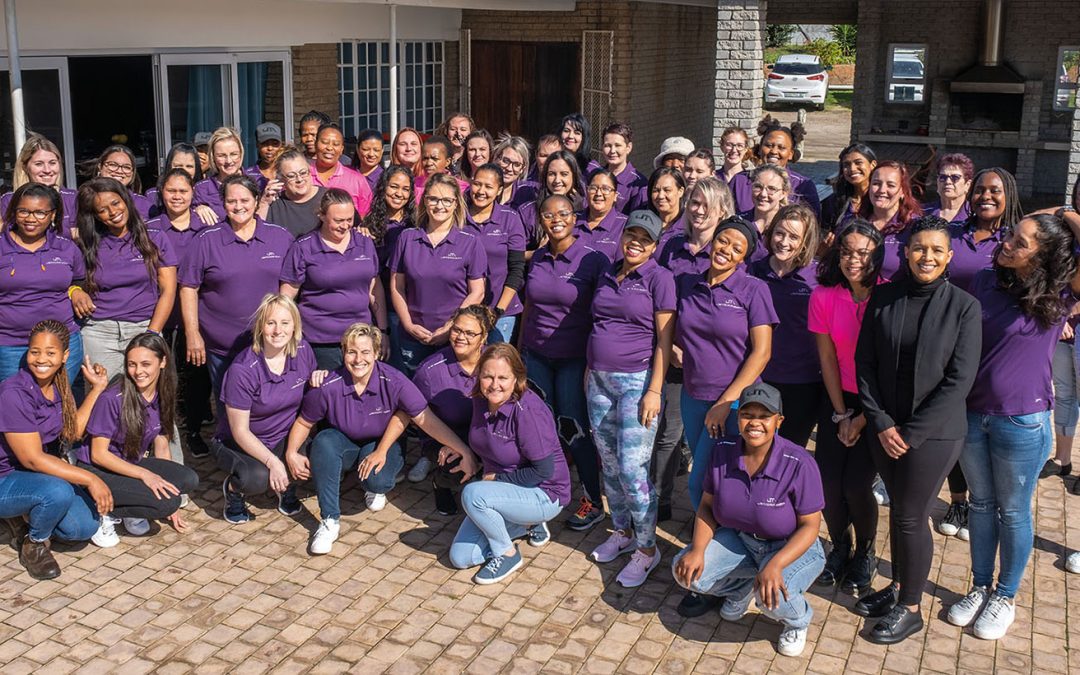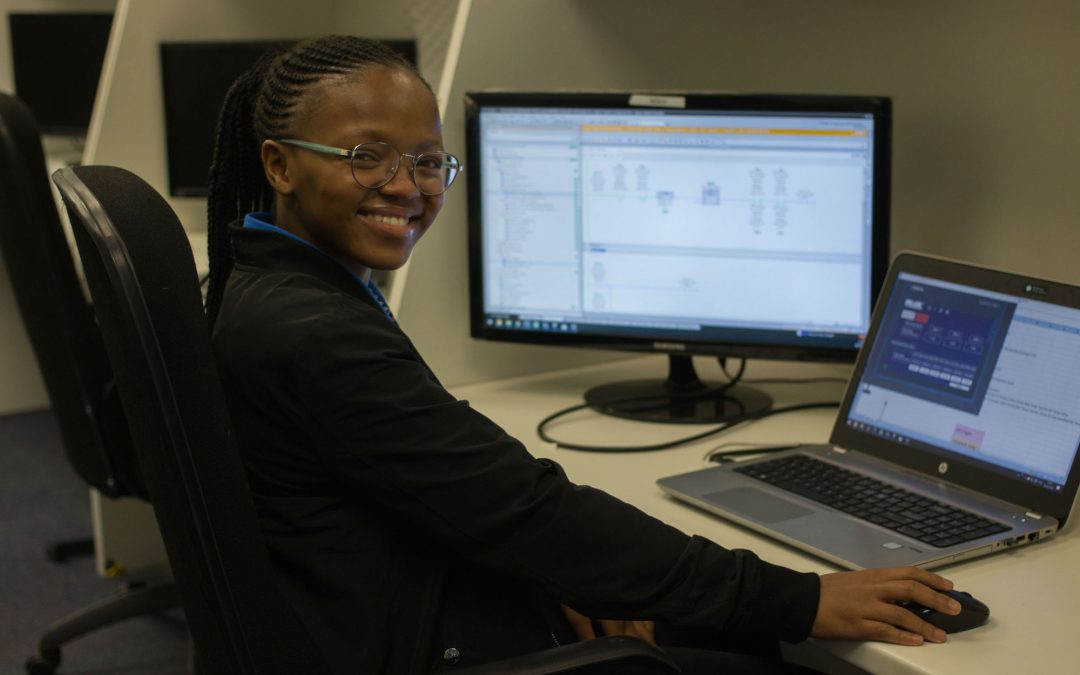
by NewsAdmin | Jan 23, 2023 | Jendamark News
It has been a trial by fire for one of ODIN Manufacturing’s newest developers, Asanda Madikizela, who, fresh from university, has risen rapidly to the challenge of making ODIN Manager a reality.
Part of the ODIN Workstation offering, ODIN Manager is a web-based application that allows customers to configure their production processes and access data straight from the production line.
“My job involves both back-end and front-end development, which is challenging and exciting at the same time,” says Madikizela, who has been working on the app for the past year.
“There’s a satisfaction one gets when that piece of code not only works but has a great interface to go with it.”
Her focus is on adding new features, making continuous improvements to existing ones, and fixing bugs to maintain efficiency and usability.
“I’m currently being challenged to create a scheduler page, which is quite complex. The gist of it is that the page must allow the user to create a scheduled job for a particular substation and assign schedules to it, which can be executed in three different ways – time based, part count or shift based. These scheduled jobs contain a list of jobs that must be executed for the operations to be marked as complete.”
She says one of the most fun and challenging aspects is ensuring that the interface is smooth and efficient to allow the user to add all the necessary information without running into complications or being unable to use the system effectively.
“I’m still brainstorming how the UI will look for this one and it’s promising to be the most exciting yet.”
Of course, moving from the front end to the back end has not been without its challenges.
“I would say I’m most proud of the work I did with the operations page rewrite, which is the most recent feature I worked on. It made me sweat and cry, and yet it brought me so much satisfaction and growth.
“The operations page had a lot of interacting tables. I remember being stuck for over a week trying to figure out how to get the image coming from a separate tab to be displayed on a second tab without having to hit the refresh button. This was previously on a separate page, and all you had to do was click a button and it would redirect you.
“I remember getting to a point in the second week where I actually went to the bathroom and cried a bit. I thought to myself, ‘I’m going to be stuck on this for another week, aren’t I?’”
Madikizela says she grappled with the problem, which was with the initialisation of the page, for days on end until a simple answer presented itself.
“Imagine my shock when, after a long and tiring trial and error, the problem was solved by only calling a certain property on the tab that allows the pages to be initialised for the first time when the user clicks on the tab.
“But honestly, I learnt a lot during that process; the most important was patience, and to continue searching for the answer even when you feel like you’ve done everything that you can. Because there’s always one more thing you can try.”

by NewsAdmin | Jan 10, 2023 | Jendamark News
Jendamark Automation’s head of finance, Jacqui Nagle, is used to crunching big numbers and making tough business decisions. We asked her for an honest account of what it’s like to be a woman in the hot seat.
“I started at Jendamark on secondment in my final year of articles, and never looked back. The passion that runs through the veins of this company is what drew me to it and keeps challenging me every day.
In my experience, talking about women in the workplace can be a very taboo subject. We are in that awkward friend zone, where we are making progress, but not quite there yet globally.
I can honestly say that being a woman at Jendamark has never been particularly challenging for me. Yes, there have been the odd nuances and usual stereotypes from colleagues or service providers, but never have I felt the need to prove myself because of my gender. This has a lot to do with the directors and the culture they have created.
Don’t get me wrong; there are challenges. As I write this, while rocking my daughter to sleep after a long day*, I know that a lot of it has to do with previous generations not changing quickly enough and the knock-on effect this has had on the generation of women currently in leadership positions.
Women are often still expected to be the default parent and homemaker, and many companies are not in tune with a woman’s needs. A big fear among women is how we become mothers without compromising our careers.
I had an older man ask if I had been bothered by work during my maternity leave. When I said ‘No, not at all!’, he was surprised and exclaimed how lucky I was. This should not be considered luck. This is how it should be in every company in every country globally. Burnout is a serious risk among this generation of career-oriented women who are also becoming moms.
However, the new generation emerging from university is putting its collective foot down when it comes to gender roles. Seeing this, I know that in the near future the discussion around women in the workplace will no longer be necessary because it will no longer be of any relevance.
One of our management team’s directives for 2022 was to hire more women. This is not because we feel women need an advantage but rather because of the value we add, which is becoming increasingly clear globally.
Women are key role players when it comes to facilitating engagement, passion and empathy within the organisation and among colleagues. Nowadays, people want more out of their jobs. It’s not just about money or status but about the intrinsic value it adds to a person’s life.
Within Jendamark, our wellness days, talent pools and employee engagement initiatives are driven largely by our female colleagues. This is testament to our passion for the well-being of all people in the workplace.
It used to frustrate me that women were stereotyped as the more emotional sex, which translates to us often being labelled aggressive instead of assertive, or argumentative instead of honest. I’ve come to realise that it simply means our passion shines through, and for that we should be proud.
I often see social media posts by women saying, ‘Let’s be more like our male colleagues – don’t apologise when you’re late, no need to say thank you…’ But this, I believe, is more reflective of historical egos than gender.
I don’t agree with changing ourselves, as men or as women, for fear of judgement. Be professional, absolutely, but let us never lose our passion or enthusiasm for what we do!”
*Disclaimer: My husband is in the next room putting my son to bed, and he cooked supper, so I’m not that hard done by!

by NewsAdmin | Dec 12, 2022 | Jendamark News
Globally, the manufacturing sector is still male-dominated, and many companies struggle to attract skilled female candidates. But with digital technologies creating previously undreamed-of job possibilities, Jendamark is working hard to redress the gender imbalance.
The management teams in both India and South Africa have set clear targets to develop a diverse and inclusive workforce across all departments.
“In a perfect world, we would want a 50:50 ratio,” says Jendamark Automation human resources manager Mariette Geldenhuys.
“But we are hopeful that with the intake of more women through our skills development programmes, such as apprenticeships, we are actively working towards closing the gender gap, especially in the traditionally ‘male’ technical roles.”
The big picture
At Jendamark India, where women currently represent 7% of the workforce, the company has set an ambitious target of doubling this in the 2023 financial year. The aim is to employ at least one or two women in every department. “The advantages of having women in the workforce are manifold,” says JMKI’s head of HR, Pallavi Chavan.
“On a micro level, working women become financially independent and will have greater control over their own lives. This encourages women to stand against physical and emotional abuse, enabling them to handle social issues and pressures. At the macro level, greater participation of women in the workforce is good for the overall economy.”
In South Africa, women are one of the under-represented minority groups covered by the Employment Equity Act.
“In terms of affirmative action, we absolutely want to contribute to the success of various policies in this regard, but our aim is always to be an equal opportunity employer and appointments will be made according to experience and merit,” explains Geldenhuys, adding that female representation has grown from 16.9% to 24% in just two years.
Digital transformation
Both Chavan and Geldenhuys agree that the rise of Industry 4.0 technologies is transforming and creating new opportunities in the manufacturing space.
“In terms of innovation, women are adding great value, but a lot can be done to encourage young girls to enter into the fields of ICT, science and technology, which will enable them to apply for the various types of jobs that will inevitably be created by 4IR trends,” says Geldenhuys.
“It will become society’s duty to empower girls to be able to pursue these careers, specifically those in rural areas where access to technology is near non-existent.”
Employer of choice
According to the human resources professionals, diversity is becoming a strategic imperative for organisations looking to build a sustainable future. Women tend to bring a different dynamic to the workplace, with collaborative management styles and multi-tasking abilities, which fosters more balanced, motivated, and creative teams, helping the business to grow to its full potential.
“But this requires change from the top and, in Jendamark’s case, this change is being driven from exactly there. Being able to offer flexibility and a positive work-life balance by incorporating various policies and incentives will make a difference in attracting and retaining these skills,” Geldenhuys says.
Both agree that Jendamark’s flexible work-from-home policy, maternity leave benefits and empowerment programmes, such as self-defence training, are making a difference.
“Ultimately, our aim, when it comes to both male and female employees, is to be the employer of choice,” affirms Chavan.

by NewsAdmin | Mar 1, 2021 | Industry 4.0, Jendamark News
Pandemic-related lockdowns and global supply chain interruptions have highlighted the need to localise – and digitalise – vehicle manufacturing processes.
According to a report by Deloitte about the impact of Covid-19 on the international automotive sector, 80% of global vehicle production involves some form of “Made in China” parts.
For developing countries like India and South Africa, deepening local supply chains could lessen this reliance, strengthen the economy and create jobs for a growing population. But the practicalities of sourcing skilled labour and ensuring that locally made products are competitive in terms of cost and quality have left suppliers struggling to implement the right solutions.
As major vehicle-producing countries in their respective regions, both India and South Africa are ripe for a smart manufacturing revolution to address these issues. Post-Covid-19, the global smart manufacturing market is projected to grow from US$181.3 billion in 2020 to US$220.4 billion by 2025.
SA MASTERPLAN
In South Africa, vehicle and component production accounts for almost a third of the country’s manufacturing output. While the Original Equipment Manufacturers and their Tier 1 component suppliers are well established, Tier 2 and 3 suppliers are underdeveloped and contribute just 20% to the automotive value chain.
The government’s new South African Automotive Masterplan, which aims to make the sector globally competitive by 2035, outlines ambitious targets such doubling direct employment and vehicle production, and increasing average local content in vehicles from 39% to 60%.
“Covid-19 will certainly cause job and production losses, and delay implementation of the plan, but the intention is clear,” says Jendamark SA’s sales and digital services director, Yanesh Naidoo.
“The plan creates serious opportunities for localisation of our supply chain, especially for black entrepreneurs, but we need to adopt new technologies and skills fast.
“The Odin Manufacturing solutions that we’ve developed are uniquely geared to the operating challenges within a developing economy. They are designed to assist deep localisation and don’t need high-end IT infrastructure. Most importantly, they don’t cause job losses,” explains Naidoo.
He points to solutions like the Odin Workstation operator guidance system and Odin Maintenance apps, which were designed to support human operators and technicians.
“Technology can equip even semi-skilled operators to perform complex tasks with minimum training, and ensure that production processes become faster, more accurate and efficient.”
SELF-RELIANT INDIA
Similarly, the Government of India’s stimulus package and the Atmanirbhar Bharat (Self-Reliant India) movement have provided the impetus for manufacturers to boost local production.
“The Indian automotive industry was at a crucial juncture when the pandemic hit,” says Jendamark India director and CEO Himanshu Jadhav.
“India had committed itself to move from BS4 to BS6 emission norms from 1 April – a seemingly impossible task was on the brink of reality when the national lockdown was announced.
“With the supply chain cut off, and the border stand-off with China creating difficulties, it exposed the industry’s dependence on other countries, as many things from raw material to complex electronic hardware were imported.
“In our own business, we were planning to bring some complex equipment from China for one of our EV customers. But we took up the challenge to ‘Make In India’. We looked for the right material and processes, scouted for local partners with similar experience, and it was a success.”
Jadhav says an over-reliance on cheap imports, in the form of critical inputs and raw materials, has created a problem for many industries.
“Unless there is input substitution where India either identifies other sources or augments domestic production, there will be continued reliance on China. We know that there are limiting factors but digitalisation can fast-track the process.”
DIGITAL JOURNEY
Jadhav says the manufacturing sector is already on a journey to digital transformation but that Covid-19 has been the catalyst to accelerate the adoption of digital technology.
“Localisation and digitalisation are now even more important than ever, as the pandemic has exposed the vulnerability of companies, industries and countries that have not embraced these factors.
“Smart technologies allow businesses to streamline processes and increase efficiency, while helping to revive the economy and restore normalcy.”
He believes localisation of the value chain from the bottom up, with intelligent automation, can help to meet uncertain demand and huge cost pressures in times such as these.
“Digital transformation is preparing the manufacturing industry for current and future interruptions or black swan events by plugging gaps across production, distribution and management.
“Moving towards digital is not a choice any more but a necessity for survival,” says Jadhav.
“New technologies are helping manufacturers to increase efficiency, enable high levels of product customisation, and improve speed to market. Covid-19 has changed the narrative around automation technology from ‘good to have’ to ‘must-have’.”
Organisations that show agility and adopt the right technologies will have a competitive advantage and a sustainable future, says Jadhav.
“It’s with such organisations that Jendamark wishes to partner and share our Odin Manufacturing ecosystem and digital services.”

by NewsAdmin | Jun 17, 2020 | Jendamark News
Jendamark has been proud to sponsor 2018 Ironman Africa champion Kyle Buckingham for the past few years. As ambassadors for our home town of Nelson Mandela Bay, Jendamark and Kyle share the traits of focus and pushing the limits of what is possible. Click on his downloadable profile below to see Kyle’s greatest achievements and his offerings as a brand ambassador and triathlon coach.

by Good News Lab | Jan 14, 2020 | Industry 4.0, Jendamark Junction, Jendamark News
Jendamark supports the Incubating Great Engineering Minds (iGEMS) programme, which is fostering a new generation of engineers ready to meet the demands of a tech-driven world.
Run under the auspices of the Unity in Africa Foundation, iGEMS is an education-to-employment initiative that aims to develop employable, passionate and skilled engineers, and also place work-ready graduates into the marketplace.
With artificial intelligence and robotics already prevalent in industry, the foundation believes the fourth industrial revolution (4IR) will require a niche set of graduates who are familiar with the demands of the world of work.
According to Jendamark’s apprentice co-ordinator Allan Bellairs, the company has been involved with iGEMS since 2016 and sees great value in the multi-layered approach to youth development and creating a talent pipeline.
“For us it’s about both skills development and socioeconomic development. It helps to fulfil our commitment to community engagement, while also assisting in the development of work-ready professional engineering graduates.”
The programme introduces the youth in Jendamark’s hometown of Nelson Mandela Bay to the technological revolution through annual coding and programming workshops. Weekly maths, science and leadership development sessions round out the supportive, holistic approach to education.
Aside from financial support for iGEMS, Jendamark also acts as a host company, facilitating site visits for participants, and absorbing one or two learners annually for a year of experiential learning and mentorship. This acts as a working “gap year” for learners who have successfully completed
Grade 12 before embarking on their tertiary studies.
“The student becomes a full-time employee at Jendamark for one year, experiencing the world of work, especially in relation to an engineering career such as electronics or robotics,” says Bellairs.
He says the year of work assists in making the transition to university easier as it links practical and theoretical knowledge, and creates a working relationship between student and industry.
“It really allows students the opportunity to change their interest in engineering into an absolute passion!”







